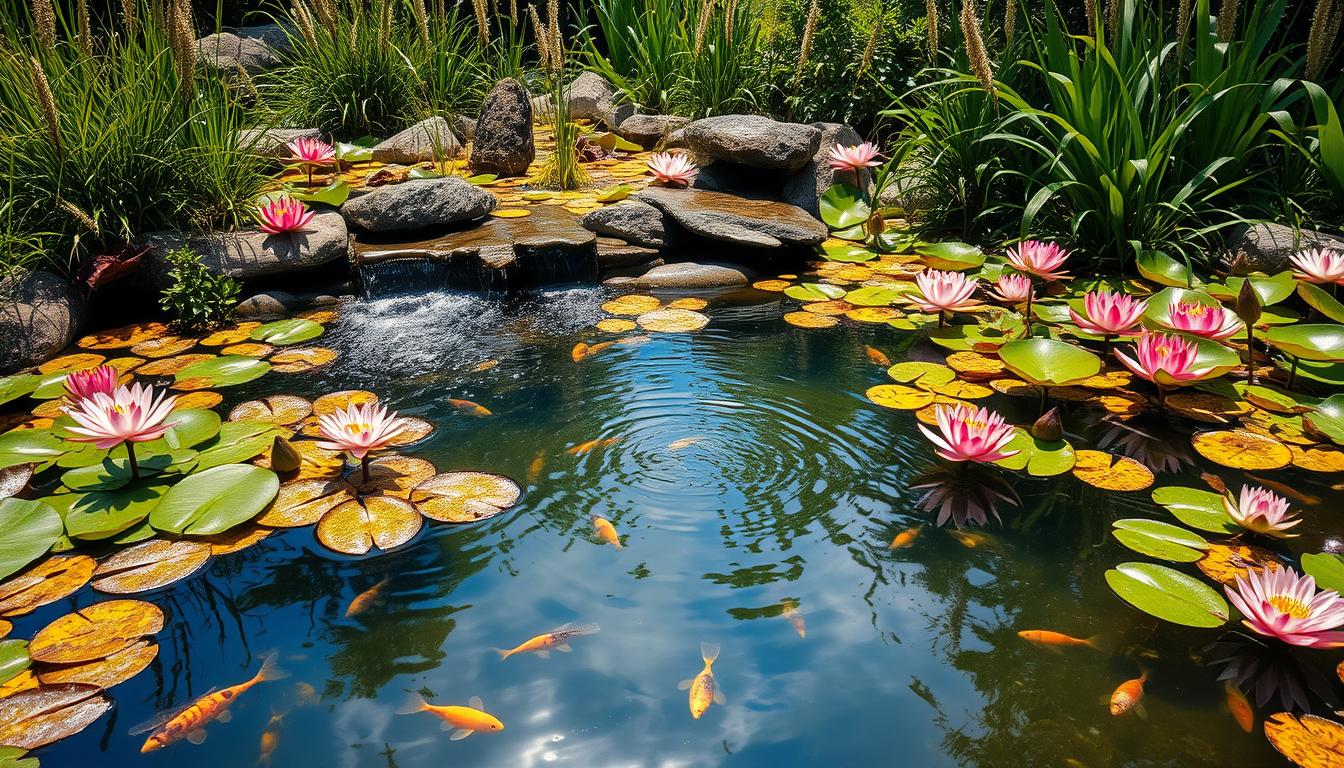Welcome to the world of aquatic gardening! I’m excited to share my top tips for creating stunning water features in your outdoor space. Whether you’re dreaming of a serene pond or eye-catching planted aquarium tanks, this guide will help you dive into this rewarding hobby.
Aquatic gardening combines the beauty of nature with the tranquility of water, offering a unique way to enhance your landscape. From selecting the right plants to maintaining water quality, I’ll cover all the essentials you need to know to create a thriving aquatic ecosystem.
Get ready to transform your backyard into a water wonderland! Let’s explore the fascinating world of aquatic gardening together and unlock the secrets to lush, vibrant water features that will be the envy of your neighborhood.
Understanding Aquatic Gardening Basics
Aquatic gardening is a fun hobby that adds life and beauty to water features. I enjoy making mini ecosystems in planted aquariums and designing outdoor water gardens. Let’s explore the basics of this exciting world.
What is Aquatic Gardening?
Aquatic gardening means growing plants in water-based settings. It can be small indoor aquariums or big outdoor ponds. The goal is to balance plants, water, and sometimes fish for a healthy ecosystem.
Benefits of Aquatic Gardening
This hobby has many benefits:
- It makes spaces look better
- It improves air quality
- It helps reduce stress and promotes calm
- It supports local wildlife
- It teaches about ecosystems
Key Elements to Consider
Success in aquatic gardening depends on several factors:
- Water quality: Regular testing and maintenance are crucial
- Lighting: Essential for plant growth and health
- Aquarium substrate: Provides nutrients and anchors plants
- Plant selection: Choose species suited to your setup
- Filtration: Keeps water clean and oxygenated
| Element | Importance | Tips for Aquatic Plant Care |
|---|---|---|
| Water Quality | High | Test weekly, maintain stable pH |
| Lighting | High | Provide 8-10 hours daily |
| Substrate | Medium | Use nutrient-rich aquarium substrate |
| Plant Selection | Medium | Mix easy and challenging species |
| Filtration | High | Clean filter monthly |
Choosing the Right Location for Your Water Feature
Finding the perfect spot for your water feature is crucial. I’ll help you pick the best location. It should have the right amount of sunlight, be easy to get to, and look good with your garden.
Sunlight Requirements
Most aquatic plants love full sun, needing 6-8 hours of direct light. To find the sunniest spots, watch your yard during the day. For shaded areas, use aquarium lighting to help plants grow.
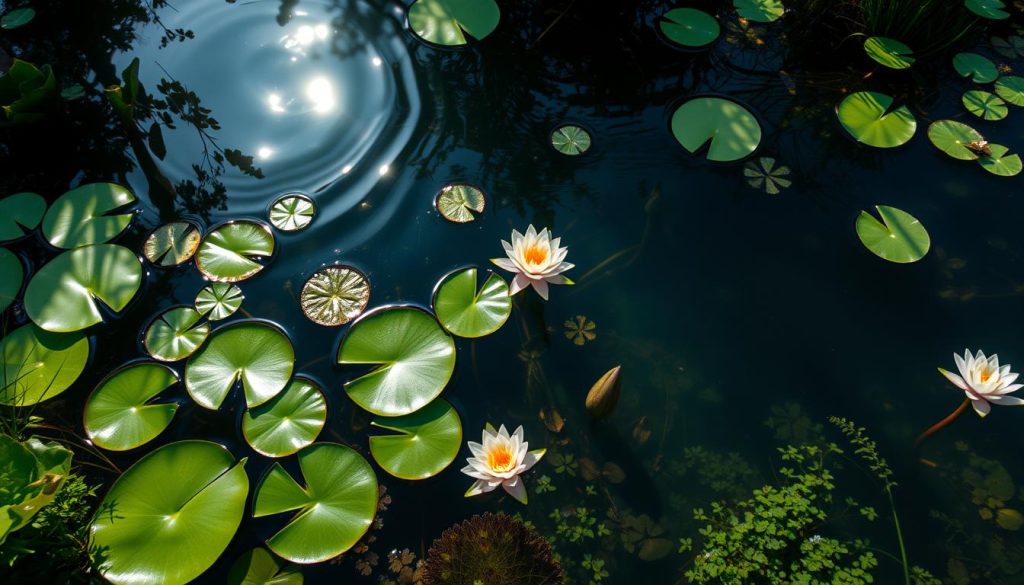
Accessibility for Maintenance
It’s important to be able to easily reach your water feature. Pick a spot where you can move around comfortably. Leave 2-3 feet of space around it for easy access.
Aesthetic Integration with Your Landscape
Your water feature should match your garden’s look. Think about the plants and design around it. Placing it near a patio or seating area makes it a beautiful centerpiece.
| Factor | Importance | Tips |
|---|---|---|
| Sunlight | High | Aim for 6-8 hours of direct sunlight |
| Accessibility | Medium | Leave 2-3 feet of clear space around the feature |
| Aesthetics | Medium | Place near seating areas for visual impact |
Selecting Aquatic Plants
Choosing the right plants is key to successful aquatic plant care. I’ll guide you through the process of selecting and caring for aquatic plants. I’ll also share some aquascaping techniques to create a stunning water feature.
Native vs. Exotic Plants
When selecting plants, consider native species. They’re adapted to local conditions and support local wildlife. Exotic plants can add unique beauty but may require extra care. I prefer a mix of both for a diverse, thriving aquatic garden.
Popular Aquatic Plants for Beginners
For newcomers to aquatic gardening, I recommend these easy-to-grow plants:
- Water Lilies: Beautiful floating leaves and flowers
- Hornwort: Excellent oxygenator and algae fighter
- Water Hyacinth: Fast-growing with lovely purple flowers
- Anacharis: Versatile submerged plant for fish habitats
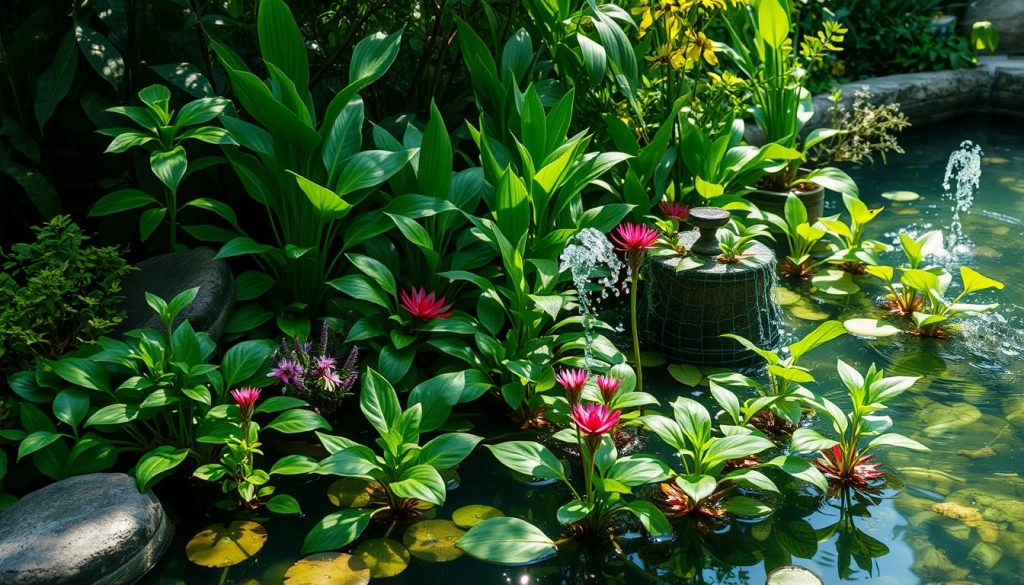
Planting Depth Considerations
Proper planting depth is crucial for aquatic plant care. Here’s a guide to help you get it right:
| Plant Type | Ideal Depth | Care Tips |
|---|---|---|
| Floating Plants | Surface | Remove excess growth regularly |
| Marginal Plants | 0-6 inches | Keep soil moist, not waterlogged |
| Submerged Plants | 12-24 inches | Ensure adequate light penetration |
| Deep Water Plants | 24-36 inches | Use planting baskets for easier management |
Remember, these aquascaping techniques will help create a balanced ecosystem in your water feature. With proper care and attention to planting depth, your aquatic garden will thrive. It will become a beautiful focal point in your landscape.
Designing Your Water Feature
Designing a water feature is exciting. I’ll show you how to do it, with lots of options and tips. You can make a stunning aquatic garden, indoors or outdoors. These ideas will help you create a beautiful space.
Types of Water Features
There are many types of water features, each with its own benefits. Here’s a quick look:
- Container gardens: Great for small spaces
- Ponds: Perfect for bigger areas
- Fountains: Add movement and sound
- Waterfalls: Give a natural, flowing look
- Planted aquarium tanks: Bring aquascaping inside
Creating Visual Interest
To make your water feature pop, try these techniques:
- Use hardscapes like rocks and driftwood
- Vary plant heights for depth
- Create focal points with unique plants or decorations
- Play with light and shadow
Planning for Plant Growth
Think about how plants will grow when designing your water feature. This planning keeps your aquascape balanced as it grows. Here’s a table with growth rates for popular plants:
| Plant Name | Growth Rate | Max Height |
|---|---|---|
| Dwarf Hairgrass | Slow | 2-4 inches |
| Amazon Sword | Fast | 20 inches |
| Java Fern | Moderate | 8-12 inches |
| Anubias | Slow | 6-8 inches |
Maintaining Water Quality
Keeping your water feature clean is key to successful aquatic gardening. I’ll share some tips to help you keep your water pristine for plants and fish.
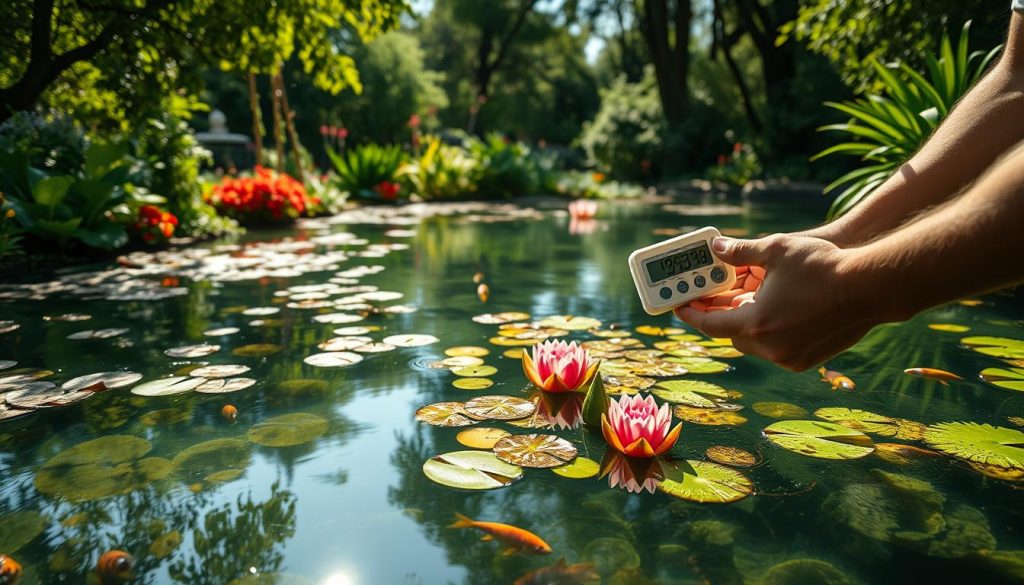
The Importance of Water Testing
Regular water testing is crucial. I test my water weekly to catch any issues early. A good test kit checks pH, ammonia, nitrites, and nitrates. These parameters affect plant growth and fish health.
Natural Filtration Techniques
I love using natural methods to keep water clean. Beneficial bacteria break down waste, while certain plants act as living filters. Water lilies and hornwort are great choices. They absorb excess nutrients, reducing algae growth.
Correcting pH and Alkalinity Levels
Balanced pH is vital for aquatic life. Most plants thrive in slightly acidic to neutral water. If your pH is off, natural buffers like crushed coral can help. For alkalinity, I use fish-safe fertilizers that don’t harm aquatic creatures while nourishing plants.
| Parameter | Ideal Range | Adjustment Method |
|---|---|---|
| pH | 6.5-7.5 | pH Up/Down solutions |
| Alkalinity | 50-150 ppm | Baking soda |
| Ammonia | 0 ppm | Partial water changes |
By following these tips and using fish-safe fertilizers, you’ll create a thriving ecosystem in your water feature. Remember, consistency is key in maintaining water quality.
Managing Algae Growth
Algae can be a big problem in aquatic gardens. I’ve faced it many times and want to share how to manage it. We’ll look at what causes it, natural ways to stop it, and chemical treatments to keep your garden clean.
Understanding the Causes of Algae
Too many nutrients and not enough plants are the main reasons for algae. When water has too much nitrogen and phosphorus, algae grow fast. Sunlight and warm weather make it worse. We need to fix these problems to stop algae.
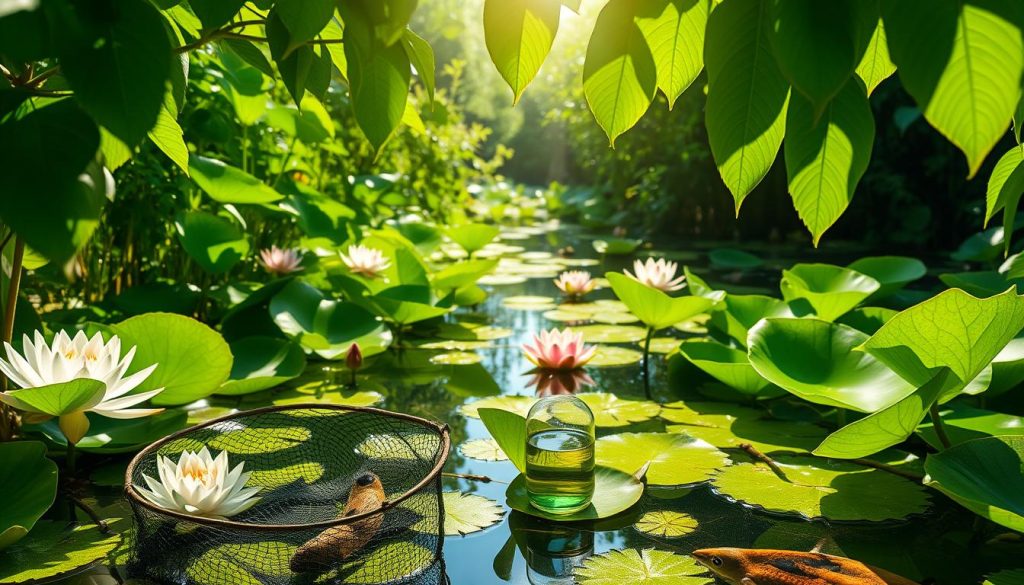
Natural Algae Control Methods
Natural ways are often the best for fighting algae. Growing more plants is a good start. More plants mean less food for algae. Floating plants like water lettuce or duckweed can also help by blocking sunlight.
Adding algae-eating fish or snails is another good idea. They help keep algae under control.
Chemical Solutions and Precautions
Chemicals might be needed for tough algae problems. Algaecides can work well, but use them carefully. Always read the instructions to protect plants and animals. Remember, chemicals just treat symptoms, not the cause.
CO2 systems for plants are also important. They help plants grow strong, competing with algae for nutrients. This balance is essential for a healthy, algae-free garden.
Supporting Aquatic Wildlife
Creating a thriving ecosystem in your water feature is key in aquatic gardening. Supporting wildlife adds beauty and balance to your planted aquarium tanks. Let’s explore some tips to make your water garden a haven for beneficial creatures.
Attracting Beneficial Creatures
To cultivate a healthy aquatic environment, I focus on attracting helpful insects. Dragonflies and damselflies are excellent additions. They eat mosquito larvae and add visual interest.
I plant tall grasses and reeds around the edges of my water feature. This gives these insects places to perch and lay eggs.
Creating Habitats for Frogs and Turtles
Frogs and turtles are wonderful additions to aquatic gardens. I create shallow areas with gently sloping sides. This helps them enter and exit the water easily.
Adding floating plants like water lilies provides shelter and basking spots for these creatures.
| Animal | Habitat Needs | Benefits to Garden |
|---|---|---|
| Frogs | Shallow water, plants for cover | Eat insects, add ambient sounds |
| Turtles | Basking areas, deeper water sections | Control algae, eat snails |
The Role of Fish in Aquatic Gardens
Fish play a crucial role in planted aquarium tanks. They help maintain balance by eating algae and providing nutrients for plants through their waste. I choose fish species that are compatible with my aquatic plants, like guppies or small goldfish.
These fish add movement and color to the garden while contributing to its overall health.
By following these aquatic gardening tips, you’ll create a vibrant ecosystem that supports a variety of wildlife. This approach not only enhances the beauty of your water feature but also promotes a natural balance that makes maintenance easier.
Seasonal Care for Aquatic Gardens
Caring for your aquatic garden changes with the seasons. I’ll guide you through year-round aquatic plant care to keep your water feature thriving.
Preparing for Winter
As temperatures drop, protect sensitive plants by moving them to deeper water. Trim back hardy plants and remove debris. For outdoor ponds, use a de-icer to prevent complete freezing. Adjust aquarium lighting to mimic shorter daylight hours, reducing it to 6-8 hours daily.
Spring Planting Tips
When spring arrives, it’s time to rejuvenate your aquatic garden. Start by cleaning the pond and checking equipment. Divide and replant overgrown plants. Introduce new varieties, ensuring proper planting depth. Gradually increase aquarium lighting to 10-12 hours daily to support new growth.
Summer Growth Maintenance
Summer brings rapid growth, requiring extra attention. Prune plants regularly to prevent overcrowding. Monitor nutrient levels and adjust fertilizer as needed. Keep an eye on water quality, testing weekly. For optimal plant health, maintain consistent aquarium lighting at 12-14 hours per day.
| Season | Aquarium Lighting (hours/day) | Key Aquatic Plant Care Tasks |
|---|---|---|
| Winter | 6-8 | Protect plants, remove debris |
| Spring | 10-12 | Clean pond, divide plants |
| Summer | 12-14 | Prune, monitor nutrients |
Troubleshooting Common Issues
Even with careful care, problems can still happen in your water feature. I’ve faced many challenges in my years of aquatic gardening. I’m here to share some solutions.
Addressing Plant Health Problems
Yellowing leaves often mean your plants need more nutrients. I add liquid fertilizer made for aquatic plants to help. For pests like aphids, I gently wash the plants with mild soap.
If fungal diseases show up, I remove the affected parts and improve water flow.
Dealing with Water Clarity Issues
Cloudy water is a common problem. I solve it by reducing feeding, boosting filtration, and doing partial water changes. It’s also key to manage algae growth for clear water.
I limit sunlight with floating plants and use barley straw extract to fight algae.
Fixing Structural Problems in the Feature
Leaks can be hard to find. I look for wet spots and check the liner seams. For pump problems, I clean the impeller and make sure water levels are right.
If you hear strange noises, it might mean debris in the pump or worn bearings.
| Issue | Possible Cause | Solution |
|---|---|---|
| Yellowing leaves | Nutrient deficiency | Add aquatic plant fertilizer |
| Cloudy water | Overfeeding, poor filtration | Reduce feeding, improve filtration |
| Pump noise | Debris or worn bearings | Clean impeller, check for damage |
Resources and Communities for Aquatic Gardeners
Let’s explore the world of aquatic gardening resources! I’ve collected a wealth of information to boost your skills and connect with others who share your passion.
Books and Online Resources
Looking for tips on aquatic gardening? Websites like AquaScaping World and The Aquarium Guide are full of ideas. For a detailed guide, check out “The Encyclopedia of Water Garden Plants” by Greg Speichert. These sources provide expert advice on aquascaping and plant care.
Local Gardening Clubs and Meetups
Learning from others is invaluable. Local gardening clubs often have groups focused on aquatic plants. The American Horticultural Society’s website can help you find clubs near you. Joining one is a great way to exchange tips and see amazing water features.
Workshops and Events to Consider
Want to improve your aquascaping skills? Look for workshops at botanical gardens or aquarium stores. The Aquatic Gardeners Association hosts an annual convention with talks and demos. These events are perfect for learning new tips and meeting experts.

